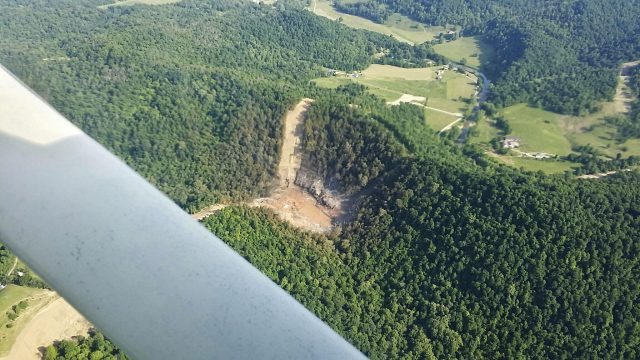23 July 2018
Leach XPress: a landslide caused a pipeline explosion on 7th June 2018
Posted by Dave Petley
Leach XPress:land subsidence caused a pipeline explosion on 7th June 2018
Leach XPress is a new $1.75 billion pipeline that transports large volumes of shale gas from the Marcellus and Utica regions of Pennsylvania, West Virginia and Ohio to consumers elsewhere in the US. The pipeline entered full service earlier this year. On 7th June 2018 it suffered a major rupture and explosion. Images of the aftermath are spectacular:-

The aftermath of the June 2018 explosion on the Leach Xpress natural gas pipeline in West Virginia. Image by Martin Dofka via WV Public Broadcasting
.
The event has been investigated by the National Transportation Safety Board. On 9th July they issued a safety order (NB PDF) to the operators noting that the failure was likely caused by “land subsidence”:-
“The preliminary investigation suggests that the Failure was the result of land subsidence causing stress on a girth weld.”
The operators have been ordered to inspect other sections of the pipeline that might be subject to similar geological conditions. The location of this event on such a steep scarp would suggest that the major problem here is likely to be subsidence caused by slope movement – and indeed some news reports have stated plainly that this event was a landslide. The NTSB letter points out that the areas of concern are related to slopes:
After evaluating the foregoing preliminary findings of fact and considering the location of the Failure Site on Nixon Ridge, the identification of six additional areas of concern based on the existence of large spoil piles, steep slopes, or indications of slips, the fact that subsidence or slippage could lead to additional failures of the pipeline in areas with similar geological conditions
Building pipelines on steep slopes is a major challenge. Interestingly, the Nature Conservancy Council and eight energy companies have teamed up to produce a report, entitled Improving Steep-Slope Pipeline Construction to Reduce Impacts to Natural Resources, to mitigate the impacts of landslides caused by the construction of pipelines on slopes. The report makes a number of recommendations. As the NCC notes, the seven pre-construction best practices are identified as follows:
- Perform a geohazard assessment
- Develop site-specific plans
- Accurately identify water features
- Identify civil or geotechnical mitigation measures
- Develop site-specific reclamation and revegetation strategies
- Potential: optimize extent of disturbed area
- Potential: evaluate environmental performance of contractors
The four recommendations for construction and restoration are identified as follows:
- Optimize placement and installation of water bars
- Optimize groundwater management
- Utilize hydroseeding and hydromulching
- Potential: optimize vegetative preservation
The final three recommendations pertain to operation and maintenance:
- Effective transition from construction
- Post-construction geohazard monitoring
- Potential: foster a culture of environmental stewardship and shared learning


 Dave Petley is the Vice-Chancellor of the University of Hull in the United Kingdom. His blog provides commentary and analysis of landslide events occurring worldwide, including the landslides themselves, latest research, and conferences and meetings.
Dave Petley is the Vice-Chancellor of the University of Hull in the United Kingdom. His blog provides commentary and analysis of landslide events occurring worldwide, including the landslides themselves, latest research, and conferences and meetings.